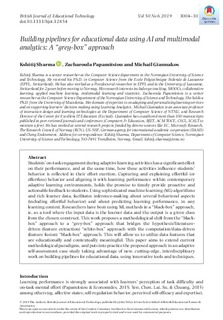| dc.contributor.author | Sharma, Kshitij | |
| dc.contributor.author | Papamitsiou, Zacharoula | |
| dc.contributor.author | Giannakos, Michail | |
| dc.date.accessioned | 2020-01-02T07:21:32Z | |
| dc.date.available | 2020-01-02T07:21:32Z | |
| dc.date.created | 2019-09-17T15:19:52Z | |
| dc.date.issued | 2019 | |
| dc.identifier.citation | British Journal of Educational Technology. 2019, 50 (6), 3004-3031. | nb_NO |
| dc.identifier.issn | 0007-1013 | |
| dc.identifier.uri | http://hdl.handle.net/11250/2634532 | |
| dc.description.abstract | Students' on‐task engagement during adaptive learning activities has a significant effect on their performance, and at the same time, how these activities influence students' behavior is reflected in their effort exertion. Capturing and explaining effortful (or effortless) behavior and aligning it with learning performance within contemporary adaptive learning environments, holds the promise to timely provide proactive and actionable feedback to students. Using sophisticated machine learning (ML) algorithms and rich learner data, facilitates inference‐making about several behavioral aspects (including effortful behavior) and about predicting learning performance, in any learning context. Researchers have been using ML methods in a “black‐box” approach, ie, as a tool where the input data is the learner data and the output is a given class from the chosen construct. This work proposes a methodological shift from the “black‐box” approach to a “grey‐box” approach that bridges the hypothesis/literature‐driven (feature extraction) “white‐box” approach with the computation/data‐driven (feature fusion) “black‐box” approach. This will allow us to utilize data features that are educationally and contextually meaningful. This paper aims to extend current methodological paradigms, and puts into practice the proposed approach in an adaptive self‐assessment case study taking advantage of new, cutting‐edge, interdisciplinary work on building pipelines for educational data, using innovative tools and techniques. | nb_NO |
| dc.language.iso | eng | nb_NO |
| dc.publisher | Wiley | nb_NO |
| dc.rights | Navngivelse-Ikkekommersiell 4.0 Internasjonal | * |
| dc.rights.uri | http://creativecommons.org/licenses/by-nc/4.0/deed.no | * |
| dc.title | Building pipelines for educational data using AI and multimodal analytics: A “grey‐box” approach | nb_NO |
| dc.type | Journal article | nb_NO |
| dc.type | Peer reviewed | nb_NO |
| dc.description.version | publishedVersion | nb_NO |
| dc.source.pagenumber | 3004-3031 | nb_NO |
| dc.source.volume | 50 | nb_NO |
| dc.source.journal | British Journal of Educational Technology | nb_NO |
| dc.source.issue | 6 | nb_NO |
| dc.identifier.doi | 10.1111/bjet.12854 | |
| dc.identifier.cristin | 1725785 | |
| dc.relation.project | Norges forskningsråd: 290994 | nb_NO |
| dc.relation.project | Norges forskningsråd: 255129 | nb_NO |
| dc.description.localcode | © 2019 The Authors. British Journal of Educational Technology published by John Wiley & Sons Ltd on behalf of British Educational Research Association This is an open access article under the terms of the Creative Commons Attribution‐NonCommercial License, which permits use, distribution and reproduction in any medium, provided the original work is properly cited and is not used for commercial purposes. | nb_NO |
| cristin.unitcode | 194,63,10,0 | |
| cristin.unitname | Institutt for datateknologi og informatikk | |
| cristin.ispublished | true | |
| cristin.fulltext | original | |
| cristin.qualitycode | 1 | |

